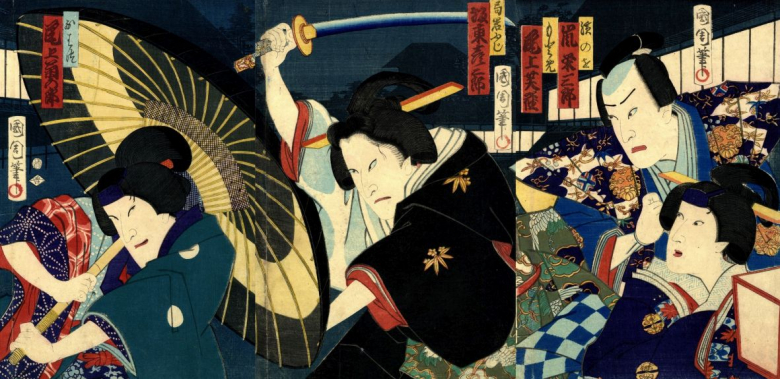Art Museum RIGA BOURSE is closed to visitors due to the current state of emergency. Current exhibitions will be on view after the reopening of the museum.
Sword fights and other tense subjects, ghosts, human-size rats, expressive make-up and gestures emphasizing the emotions of the actors, and colourful costumes are only a small part of the world that can be viewed in the works of this exhibition. It is life as performed by kabuki actors, in Japan’s Edo period (1603–1868).
There are about 380 exhibits in the collection of Japanese graphics at the Latvian National Museum of Art, with the largest number being ukiyo-e – a genre of graphics, which can be literally translated as the “pictures of the floating world”. Ukiyo-e masters mainly portrayed kabuki theatre actors, beautiful women, sumo wrestlers, warriors, scenes from history and folk tales, travelling scenes, landscapes, nature and animals, as well as works of erotic nature. In this way, they revealed the energy-filled popular culture of the Edo period, which flourished in the largest Japanese cities. The works in the museum collection mostly relate to the kabuki theatre theme.
Kabuki is a traditional form of Japanese theatre which was created and matured in the Edo period and combined singing, music, dance, and drama. Along with the noh and bunraku theatres, kabuki is recognized as one of the three main forms of classical Japanese theatre and is included in the UNESCO List of Intangible Cultural Heritage. Kabuki initially developed as a theatre which expressed the interests of the middle class or merchants with the actors presenting their performances on everyday themes, historical events and the resolution of moral ethical issues. The portrayals by the kabuki theatre actors were the most highly demanded among the fans of the ukiyo-e artists and actors.
The works of three productive and commercially successful artists from the 19th century can be seen at the exhibition – Utagawa Kunisada (歌川国貞, 1786–1865), who was also one of the leading trendsetters in his field, Kunisada’s student and active portrayer of kabuki actors, Toyohara Kunichika (豊原国周, 1835–1900) and Utagawa Kuniyoshi (歌川国芳, 1797–1861), one of the last great Japanese ukiyo-e masters.
The visitors of the exhibition have the possibility to discover more about the various elements of kabuki theatre by watching the film 歌舞伎 KABUKI. Japan’s Classical Theatre (1964), this documentary is from the collection of Science Film Museum in Japan.
EXHIBITION CURATOR:
Kristīne Milere, Exhibition Curator, Art Museum RIGA BOURSE / Latvian National Museum of Art
EXHIBITION WORKING GROUP:
Preparation of the collection for exhibition:
Valentīna Opolā, Curator of the Graphic Art Collection, Art Museum RIGA BOURSE / Latvian National Museum of Art
Una Kastanovska, Head of the Conservation Department / Latvian National Museum of Art
Inga Rozefelde, Work of Art on Paper Conservator / Latvian National Museum of Art
Arvils Vilkaušs, Framing Specialist / Latvian National Museum of Art
Japanese culture and language:
Mg. paed. Uģis Nastevičs, Japanese translator, guide
Visual identity:
Kristīne Jansone, Visual Communication Specialist, Art Museum RIGA BOURSE /
Latvian National Museum of Art
EDUCATION PROGRAMME:
Lilita Pudule, Curator of Education, Art Museum RIGA BOURSE / Latvian National Museum of Art
Vita Ozoliņa, Curator of Education, Art Museum RIGA BOURSE / Latvian National Museum of Art
Sandra Ķempele, Curator of Education, Art Museum RIGA BOURSE / Latvian National Museum of Art
Gallery name: RIGA BOURSE
Address: Doma laukums 6, Riga
Opening hours: Tue-Sun 10:00 - 18:00
Open: 29.02.2020 - 26.08.2020







